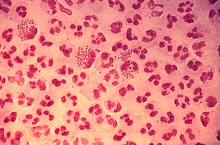Neisseria gonorrhoeae
| Neisseria gonorrhoeae | |
|---|---|

| |
| Pewarnaan gram gonococcal urethritis. Terlihat distribusi neutrofil dan kehadiran bakteri intraseluler dan ekstraseluler. (CDC) | |
| Klasifikasi ilmiah | |
| Domain: | |
| Filum: | |
| Kelas: | Betaproteobacteria
|
| Ordo: | Neisseriales
|
| Famili: | Neisseriaceae
|
| Genus: | Neisseria
|
| Spesies: | N. gonorrhoeae
|
| Nama binomial | |
| Neisseria gonorrhoeae (Zopf 1885) Trevisan 1885[1]
| |
| Sinonim | |
| |
Neisseria gonorrhoeae merupakan bakteri gram negatif, nonmotil, tidak membentuk spora, berkembang berkoloni membentuk diplokokus, ataupun tunggal monokokus.[3] Bakteri ini ditemukan dan diisolasi oleh Albert Neisser pada tahun 1879.[4] Manusia merupakan satu-satunya inang alami bakteri ini. Untuk menginfeksi, bakteri membutuhkan kontak langsung dengan mukosa tubuh, bisa lewat hubungan seks, atau penggunaan kloset duduk. Bakteri ini menempel dengan pilinya.[5]
Pertumbuhan
[sunting | sunting sumber]Neisseria gonorrhoeae menunjukkan pertumbuhan paling baik pada media dengan penambahan cairan tubuh seperti darah. N. gonorrhoeae bersifat aerobik hingga anaerobik fakultatif. Bakteri ini tumbuh optimal pada suhu 37°. Koloni yang terbentuk berukuran kecil, transparan, dengan tepi yang berlekuk.[6]
Referensi
[sunting | sunting sumber]- ^ "Neisseria". In: List of Prokaryotic Names with Standing in Nomenclature (LPSN). Created by J.P. Euzéby in 1997. Curated by A.C. Parte since 2013. Available on: http://www.bacterio.net. Retrieved 7 July 2017.
- ^ Neisser, A. Ueber eine der Gonorrhoe eigentümliche Micrococusform. Centralblatt für die medizinischen Wissenschaften 17 (28): 497-500. link.
- ^ (Inggris) Fauci, Anthony S. (2008). principles of Internal medicine. McGraw-Hill's company. ISBN 978-0-07-147691-1.
- ^ O'Donnell, Judith A.; Gelone, Steven P. (2009). Pelvic Inflammatory Disease (dalam bahasa Inggris). Infobase Publishing. ISBN 9781438101590.
- ^ (Inggris) Kumar, Vinay (2004). Robbins & Cotran Pathologic Basis of Disease. Elsevier. ISBN 978-0-7216-0187-8.
- ^ Breed, Robert. S; Murray, E.G.D.; Smith, Nathan R. (1957). Bergey's manual of determinative bacteriology (edisi ke-7th ed.). Baltimore: Williams & Wilkins Co. hlm. 482.
Pranala luar
[sunting | sunting sumber]- Todar, Kenneth. "Pathogenic Neisseriae: Gonorrhea, Neonatal Ophthalmia and Meningococcal Meningitis". Todar's Online Textbook of Bacteriology.
- Gonorrhea di eMedicine
- "Neisseria gonorrhoeae". NCBI Taxonomy Browser. 485.
Text is available under the CC BY-SA 4.0 license; additional terms may apply.
Images, videos and audio are available under their respective licenses.
